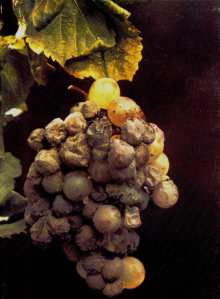Sauternes
This style used to be very popular and in the recent years has slightly dropped in popularity. Regardless, it is still a very complex wine. Botrytis-infected berries are hand-picked during the late harvest season. Botrytis is a mold that in wet conditions causes a spoilage of grape berries. While in dry conditions Botrytis causes a dehydration and flavor concentration of grape berries. In the case of Sauternes, Botrytis is formed under dry conditions, which is commonly labeled as "noble rot." Typically, only Sauvignon Blanc, Semillon, and Muscat grape varieties are used for Sauternes. Once the berries are harvested, they are then pressed and put immediately into barrels. Fermentation is slow and usually stops around 13 to 14% alcohol, max. The fermented wine is then stored in new oak barrels for about 3 and a half years before bottling.

Noble Rot (Photo from Richard Zowie)
As a region, Sauternes is located about 25 miles southeast of Bordeaux in the Graves district of France. Sauternes, as a wine, is rich in flavor with a noticeable honeyed flavor accomplished by Botrytis. The wine is also very sweet. The most recognized Sauternes in the world is made by Chateau D'Yquem.
Tokaji (Tokay)
Tokaji is in a class all of itself. These wines, which have some of the longest history known to the world of wine, are made in Hungary primarily from the Furmint variety. Additionally some degree of Harslevelu and Muskotaly varieties may be added. Again, grapes are infected with Botrytis, concentrating flavors and sugars in grape berries. A thrifty Tokaji: Disznoko Tokaji Aszu 4 Puttonyos ($30 for 500 mL), with lots of honey, spice, apricot, and citrus flavors.
Trockenbeerenauslesen
Made in Germany, primarily from the Riesling variety, these wines are quite delicate and pleasant. Unlike it's counterparts, Trockenbeerenauslesens never see oak, and alcohol content is usually much, much lower than a Sauternes. Additionally, wines are usually crystal clear, as they experience some level of filtration prior to bottling. In my time, I have tasted several different levels of German wines. The Trockenbeerenauslesen wines are usually the most expensive, but oh so different and unique from any other dessert wine out there.
Icewine (Eiswein)
The principle is the same. Here, sugar is concentrated by desiccation of berries due to freezing. Grapes are left on the vines to hang long into the winter months and picked with ice surrounding them. Fermentation is slow and cold, but the result is a sweet, acidically balanced wine. New York and Canada have popularized Icewine fermentations, and I have to admit that tasting several Icewine varietals for a dessert is quite pleasant. I remember this experience in Florida (far away from ice) where a flight of 5 Icewines were put in front of me for dessert. It was fabulous. I had expected many of them to taste the same, but the variety and unique nature among each icewine was superb! If you ever are in need of a fun dessert, splurge on buying 4 or 5 different icewines, serve as a flight (each person receives a glass of each... remember, use smaller glasses for dessert wines), and taste each one right after another. Your guests will not be disappointed.

Icewine Harvest in Ontario (Photo from The Washington Post)
Cryoextraction
Cryoextraction involves manually freezing grapes to concentrate sugars, acid, and flavors much like icewine. The difference is that grapes are picked, then frozen as opposed to left hanging on the vines during the freezing months. There are some great dessert style wines out there that are cryoextracted (or I believe they are). Check out Linden Vineyards Late Harvest Vidal and Late Harvest Petit Manseng and Veritas Vineyard & Winery Kenmar, which has received much attention recently.
Food Pairings with "Dessert Wines":
Generally speaking, match the color of the dessert wine with your dessert!
1) By itself
2) cheeses (especially blue cheeses and soft cheeses)
3) fresh fruits (especially white fruits like pears, apricots, and peaches)
4) foie gras
5) pates
6) smoked salmon or smoked mackerel
7) shellfish
8) ice cream
9) cheesecake
10) puddings
11) fruit tarts
12) chocolate (head caution with this one - chocolate is usually paired better with ports and brandy, but... I'm throwing this in here for entertainment!)
Doesn't this just make you want dessert???


No comments:
Post a Comment